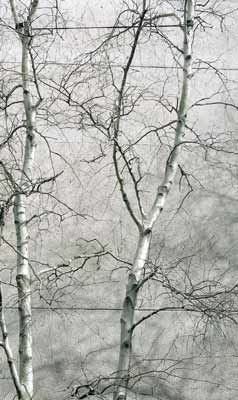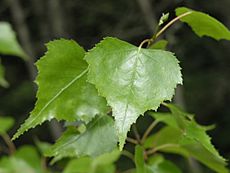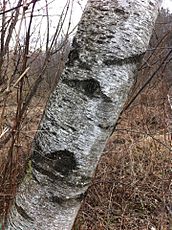Gray birch facts for kids
Quick facts for kids Gray birch |
|
|---|---|
 |
|
| Gray birches in winter | |
| Conservation status | |
| Scientific classification | |
| Genus: |
Betula
|
| Species: |
populifolia
|
 |
|
| Natural range of Betula populifolia | |
The Gray Birch, also known as Betula populifolia, is a type of tree that loses its leaves every year. It grows naturally in eastern North America. This tree is often called "gray birch" because of its unique bark. It is a fast-growing tree, but it usually lives for only about 30 years.
Contents
Where Gray Birch Trees Grow
Gray Birch trees are found in eastern North America. Their natural home stretches from southeastern Ontario in Canada all the way east to Nova Scotia. They also grow south into states like Pennsylvania and New Jersey. You can find smaller groups of these trees in Indiana, Virginia, and North Carolina.
These trees prefer places with poor, dry soil, like old fields. They are also found in moist forests where different types of trees grow together. Because they grow quickly, they are often the first trees to appear in areas that have been cleared or burned. This makes them a "pioneer species." It is possible that they no longer grow in Delaware.
What Gray Birch Trees Look Like
Gray Birch trees grow quickly and can reach heights of 20 to 30 feet (about 6 to 9 meters). Their main trunk can be up to 15 inches (about 38 centimeters) wide. The tree often has several trunks growing from an old stump. Its branches are thin, forming an open, uneven shape.
Leaves of the Gray Birch
The leaves of the Gray Birch are about 5 to 7.5 centimeters long and 4 to 6 centimeters wide. They are arranged one after another along the branch. Each leaf is shaped like an oval and tapers to a long, pointed tip. The top side of the leaf is dark green and smooth. The underside is a lighter green. The edges of the leaves have rough, saw-like teeth.
Bark of the Gray Birch
The bark of the Gray Birch is usually chalky white or grayish white. It has black triangle-shaped patches where branches meet the trunk. It can look a lot like the bark of the Paper Birch (Betula papyrifera). However, the Gray Birch's bark is smooth and thin, and it does not peel off easily like the Paper Birch's bark does.
Flowers and Fruit of the Gray Birch
The flowers of the Gray Birch are called catkins. They are pollinated by the wind. The catkins are about 5 to 8 centimeters long. The male catkins hang down, while the female catkins stand upright. In the autumn, the tree produces its fruit. This fruit is made of many tiny seeds that have wings. These seeds are packed tightly between the parts of the catkin.
Uses of Gray Birch Wood
The wood from the Gray Birch tree is medium hard. It is used for many things. People use it to make high-quality plywood and furniture. It is also used for drum shells, spools, and as firewood.
Challenges for Gray Birch Trees
Like other birch trees in North America, the Gray Birch is quite strong against a pest called the bronze birch borer. This insect can harm trees. The leaves of the Gray Birch are also a food source for different types of moths and butterflies, such as the leaf miner moth Cameraria betulivora.
Between the 1930s and 1950s, many Gray Birch trees were affected by a problem called "birch dieback disease." This disease also harmed Paper Birch and Yellow birch (Betula alleghaniensis) trees. It caused many of them to become sick and die.
Gray Birch in Landscaping
Gray Birch trees are often planted in gardens and parks, especially in southern Pennsylvania and New Jersey. This is because they can handle heat and humidity better than Paper Birch trees. They are also more resistant to the bronze birch borer and leaf miner insects, which makes them a good choice for planting.
Gallery
See also
 In Spanish: Betula populifolia para niños
In Spanish: Betula populifolia para niños




